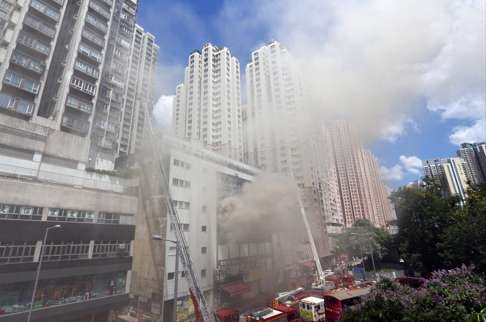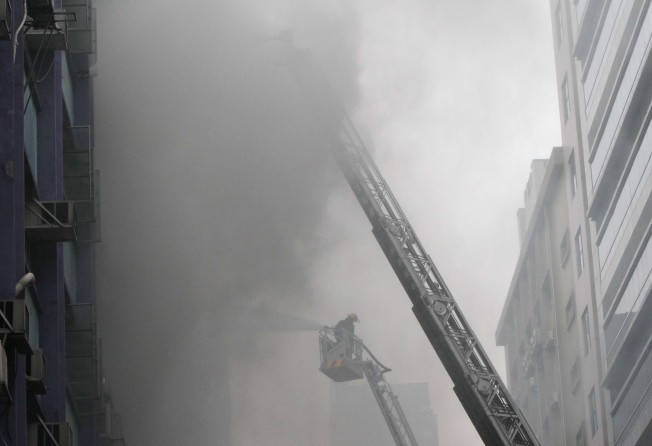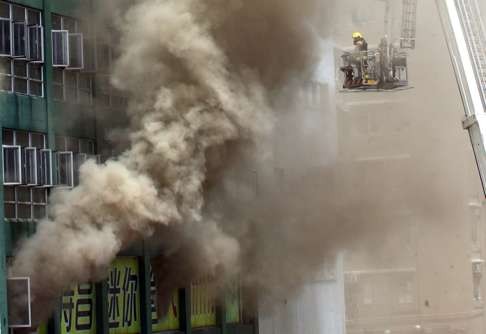
Did Hong Kong learn nothing from firefighter’s death six years ago?
Security minister does not rule out legislative changes; experts suggest setting out need for fire escapes and having sufficient space and ventilation in the densely packed storage areas

The entire floor of a 50-year-old industrial building was gutted as an intense fire swept through it in the absence of a sprinkler system. A firefighter was trapped and killed while fighting the blaze, prompting outpourings of sympathy, while exposing the hazards and lax oversight of fire safety in old factory buildings.
This tragedy occurred six years ago at the Lai Cheong Factory Building in Cheung Sha Wan. But parallels are being drawn with the fire that broke out at a mini-storage area on the third floor of a 51-year-old Ngau Tau Kok industrial building on Tuesday.
As demand for such storage facilities increases in the face of limited space in the city along with the under-utilisation of old industrial buildings, experts believe there is an urgent need for the government to set special fire safety standards for loosely regulated premises.
Old industrial buildings are subdivided to provide space for companies or individuals to store belongings if they have run out of space in their own premises.
“The incident shows how the city has overlooked the fact that mini-storage areas in old industrial buildings can carry such high potential safety risks,” Institute of Architects board member Ivan Ho Man-yiu said.

Under the current legal framework, building plans or approval permits are not required for storage areas in industrial buildings, meaning the government has limited regulatory oversight of them.
In a reply to legislative questioning last year, development chief Paul Chan Mo-po admitted that even the Lands Department did not have statistics on the number of units in industrial buildings being used and rented out for mini-storage purposes.
“Even safe box operations of banks are subject to some sort of licensing and approval mechanism, but there is no way to monitor mini-warehouses,” Ho said.
Ho said stepped-up fire safety regulations for such premises would have to include mandating standard passageway widths and distances to a “protected lobby”, or safe zone. They would also have to regulate the use of materials in storage units as the right ones would be able to “compartmentalise” and contain a fire and prevent it from going out of control.
Fire safety expert Professor Cheung Kwok-pun of the department of architecture at the university of Hong Kong said fire services, buildings and lands department officers should step up monitoring by requiring operators of mini-storage areas to comply with specialised fire safety requirements.
“These mini-storage areas are very different from regular factory spaces. They have been divided into densely packed units by metal sheets in a tight space,” he said.
“[Firefighters] had no idea what was burning inside. It could have been chemicals and oil from things such as compact discs and perfumes, burning items that would have caused sudden increases in temperature.”
He called for both the fire services and buildings departments to require operators to install automatic water sprinklers and appropriate openings to release smoke and submit risk assessments on how they would facilitate a rescue or firefighting operation.

Former Institute of Surveyors president Vincent Ho Kui-yip agreed that specific safety regulations were needed for storage areas, but it also depended on the responsibility of an operator to design and manage the warehouse safely.
“Many would want to maximise space from a profit perspective, but an operator must be clear about the risks,” he said. “When you divide the space, you must consider things like passage to a fire escape, whether there is sufficient space, ventilation and in the event of smoke, whether people can see where they’re going.”
Ho said there was also a need for the operator to set rules or guidelines on how and what customers could store in the cubicles.
Currently, mini-storage areas can only be regulated under the land leases of buildings. They are considered a type of godown or warehouse, and industrial buildings without such stated use can be found in breach of the land lease. But as part of the government’s strategy to revitalise such structures, many have applied for changes to how they are used.
Since 2010, 68 applications for wholesale conversion and eight for redevelopment have been approved. They provided about 1.06 million square metres of floor area for commercial and other non-industrial use.
On Wednesday, Secretary for Security Lai Tung-kwok admitted that although fire safety standards had generally improved over the years, the law still did not require old industrial buildings to “fit modern-day safety requirements.” He said the government would not rule out amending legislation.
A spokesman for the Lands Department confirmed that the Amoycan Industrial Centre in Ngau Tau Kok had no specific restrictions on use and had not breached its lease.